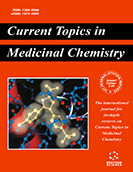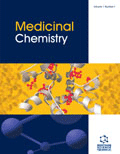摘要
背景:MDA-9 / Syntenin的过度表达发生在多种人癌细胞系中,并且与更高等级的肿瘤分类,侵袭性和转移相关。在某些情况下,它在癌症生物学中的作用取决于MDA-9 / Syntenin和NF-κB之间的关系。 目的:本研究旨在分析人类肝癌中MDA-9 / Syntenin - NF-κB - RKIP之间存在的调节环。 方法:用siRNA抗MDA-9 / Syntenin进行瞬时转染。通过Real time-PCR和Western印迹评估不同因子的表达,而通过TransAM测定激活NF-κB。通过Matrigel Invasion Assay分析侵袭能力,并通过MTS测定检查试剂对细胞活力的影响。 结果:我们检测了人肝癌(HA22T / VGH,Hep3B和HepG2)的三种细胞系中MDA-9 / Syntenin的基础表达。在所有细胞系中,MDA-9 / Syntenin和RKIP表达水平之间存在反比关系,并且MDA-9 / Syntenin表达与NF-κB活化水平之间存在正相关。通过用siRNA抗MDA-9 / Syntenin沉默,我们在所有细胞系中观察到mRNA水平上RKIP的非常强烈的增加。有趣的是,在所有细胞系中,MDA-9 / Syntenin表达的抑制诱导NF-κB下调,并且当前MMP-2依赖性的侵袭能力降低。最后,当与姜黄素或阿霉素结合时,我们显示MDA-9 / Syntenin siRNA对细胞生长抑制具有良好的累加效应。 结论:我们的数据证实了MDA-9 / Syntenin在HCC生物学中的关键作用。 MDA-9 / Syntenin,NF-κB和RKIP中存在调节环提供了新的药理学方法。
关键词: MDA-9 / Syntenin,NF-κB,RKIP,药物靶标,HA22T / VGH,Hep3B,HepG2。
Current Molecular Medicine
Title:Potential Therapeutic Applications of MDA-9/Syntenin-NF-κB-RKIP Loop in Human Liver Carcinoma
Volume: 18 Issue: 9
关键词: MDA-9 / Syntenin,NF-κB,RKIP,药物靶标,HA22T / VGH,Hep3B,HepG2。
摘要: Background: Overexpression of MDA-9/Syntenin occurs in multiple human cancer cell lines and is associated with higher grade of tumor classification, invasiveness and metastasis. In some cases, its role in cancer biology depends on relationships between MDA-9/Syntenin and NF-κB.
Objective: This study aims to analyze the presence of a regulation loop like that between MDA-9/Syntenin - NF-κB - RKIP in human liver carcinoma.
Methods: Transient transfection was performed with siRNA anti-MDA-9/Syntenin. Expression of different factors was evaluated by Real time-PCR and Western blotting, while NF-κB activation by TransAM assay. Invasion capacity was analyzed by Matrigel Invasion Assay and the effects of agents on cell viability were examined by MTS assay.
Results: We have examined basal expression of MDA-9/Syntenin in three cell lines of human liver carcinoma (HA22T/VGH, Hep3B and HepG2). In all cell lines there was an inverse relationship between MDA-9/Syntenin and RKIP expression levels, and a positive correlation between MDA-9/Syntenin expression and NF-κB activation levels. By silencing with a siRNA anti-MDA-9/Syntenin we observed in all cell lines a very strong increase of RKIP at mRNA level. Interestingly, in all cell lines, inhibition of MDA- 9/Syntenin expression induced NF-κB downregulation and contemporary a reduction in invasion ability MMP-2 dependent. Finally, we showed a good additive effect of MDA- 9/Syntenin siRNA when associated with Curcumin or Doxorubicin on cell growth inhibition.
Conclusion: Our data confirm the key role of MDA-9/Syntenin in HCC biology. The presence of a regulation loop among MDA-9/Syntenin, NF-κB and RKIP provide new pharmacological approaches.
Export Options
About this article
Cite this article as:
Potential Therapeutic Applications of MDA-9/Syntenin-NF-κB-RKIP Loop in Human Liver Carcinoma, Current Molecular Medicine 2018; 18 (9) . https://dx.doi.org/10.2174/1566524019666190104105043
| DOI https://dx.doi.org/10.2174/1566524019666190104105043 |
Print ISSN 1566-5240 |
| Publisher Name Bentham Science Publisher |
Online ISSN 1875-5666 |
 18
18 3
3 1
1
- Author Guidelines
- Graphical Abstracts
- Fabricating and Stating False Information
- Research Misconduct
- Post Publication Discussions and Corrections
- Publishing Ethics and Rectitude
- Increase Visibility of Your Article
- Archiving Policies
- Peer Review Workflow
- Order Your Article Before Print
- Promote Your Article
- Manuscript Transfer Facility
- Editorial Policies
- Allegations from Whistleblowers
Related Articles
-
Design of Lipophilic Prodrugs to Improve Drug Delivery and Efficacy
Current Drug Targets Magnetic Materials for the Selective Analysis of Peptide and Protein Biomarkers
Current Medicinal Chemistry The Genetic Landscapes of Inflammation-Driven Gastrointestinal Tract Cancers
Current Pharmaceutical Design Safety and Efficacy of Immune Checkpoint Inhibitors in Children and Young Adults with Haematological Malignancies: Review and Future Perspectives
Cardiovascular & Hematological Agents in Medicinal Chemistry Sphingolipid Metabolism and Drug Resistance in Hematological Malignancies
Anti-Cancer Agents in Medicinal Chemistry Radionuclide Antibody-Conjugates, a Targeted Therapy Towards Cancer
Current Radiopharmaceuticals Targeting Cancer Stem Cell Lines as a New Treatment of Human Cancer
Recent Patents on Anti-Cancer Drug Discovery Stem Cell Transplantation in Pediatric Leukemia and Myelodysplasia: State of the Art and Current Challenges
Current Stem Cell Research & Therapy Computational Insights for the Discovery of Non-ATP Competitive Inhibitors of MAP Kinases
Current Pharmaceutical Design Merlin, a “Magic” Linker Between the Extracellular Cues and Intracellular Signaling Pathways that Regulate Cell Motility, Proliferation, and Survival
Current Protein & Peptide Science Targeting the Voltage-Dependent K+ Channels Kv1.3 and Kv1.5 as Tumor Biomarkers for Cancer Detection and Prevention
Current Medicinal Chemistry Circulating Tumor Cells: A New Window for Diagnosis and Evaluation of Cancer
Anti-Cancer Agents in Medicinal Chemistry Epigenetic Modifications in Acute Lymphoblastic Leukemia: From Cellular Mechanisms to Therapeutics
Current Gene Therapy New Insights Into the Molecular Mechanisms of Action of Bisphosphonates
Current Pharmaceutical Design DNA Mismatch Repair Deficiency, Resistance to Cancer Chemotherapy and the Development of Hypersensitive Agents
Current Topics in Medicinal Chemistry Structure-Activity Relationship Studies on Holy Basil (Ocimum sanctum L.) Based Flavonoid Orientin and its Analogue for Cytotoxic Activity in Liver Cancer Cell Line HepG2
Combinatorial Chemistry & High Throughput Screening Expression and Function of PPARs in Cancer Stem Cells
Current Stem Cell Research & Therapy Chemistry and Biological Activity of [1,2,3]-Benzotriazine Derivatives
Current Organic Chemistry Cancer Stem Cells: The Emerging Challenge of Drug Targeting
Current Medicinal Chemistry Phenothiazines and Related Drugs as Multi Drug Resistance Reversal Agents in Cancer Chemotherapy Mediated by p-glycoprotein
Current Cancer Therapy Reviews

















.jpeg)








